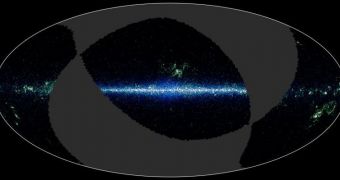A group of experts from NASA has released data collected by the WISE telescope to the international astronomical community. Members of the team say that this will undoubtedly result in numerous discoveries, considering that that observatory was able to image hundreds of millions of objects.
The Wide-field Infrared Survey Explorer (WISE) was launched on December 14, 2009, and conducted investigation around the clock for more than a year. It featured 4 primary infrared light detectors, of which two worked at wavelengths that required them to be cooled to extremely low temperatures.
As it conducted its investigations, the telescope spun across the sky, producing bundles of data that contain information about hundreds of millions of asteroids, near-Earth objects, meteorites, stars and galaxies. Experts are now free to browse through these datasets and look for new phenomena.
“Starting today thousands of new eyes will be looking at WISE data, and I expect many surprises,” explains the principal investigator of the WISE mission, University of California in Los Angeles expert Edward Wright.
Before the telescope ran out of hydrogen coolant, in early October, 2010, it managed to conduct one and a half full surveys of the night sky, collecting a grand total of about 2.7 million images. After the coolant ran out, two of its four detectors became nonoperational.
The other two continued to collect data for about four months, until the mission was finally shut down due to lack of funding. The extended observations campaign was mostly focused on the objects in the inner asteroid belt.
This led to the discovery of more than 20 new comets, 33,000 new asteroids between the orbits of Mars and Jupiter alone, and 133 near-Earth objects (NEO). WISE therefore increased the wealth of data we already had on the IAB. Studies of this area could lead to a better understanding of the solar system.
“We are excited that the preliminary data contain millions of newfound objects,” explains WISE project manager Fengchuan Liu, who is based at the NASA Jet Propulsion Laboratory (JPL), in Pasadena.
“But the mission is not yet over – the real treasure is the final catalog available a year from now, which will have twice as many sources, covering the entire sky and reaching even deeper into the Universe than today's release,” he goes on to say.
“WISE is providing the newest-generation 'address book' of the infrared universe with the precise location and brightness of hundreds of millions of celestial objects,” adds expert Roc Cutri.
“WISE continues the long tradition of infrared sky surveys supported by Caltech, stretching back to the 1969 Two Micron Sky Survey,” says Cutri, who is the lead scientist for WISE data processing at the Caltech Infrared Processing and Analysis Center.

 14 DAY TRIAL //
14 DAY TRIAL //